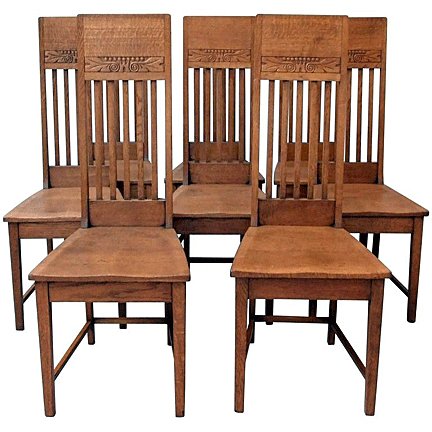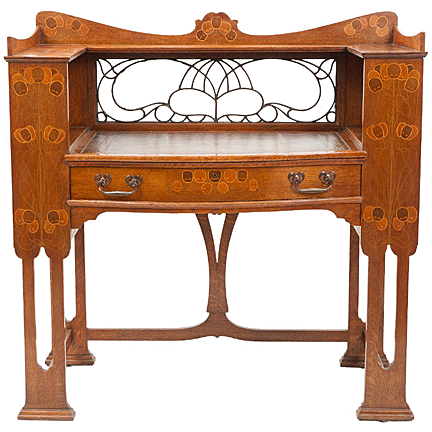|
Taking Furniture Design in a New Direction
by
Bob Brooke
 The
Victorians had their revivals—all seven of them. By the last quarter of
the 19th century, some British designers felt it was time for a new
direction in furniture design, inspired by William Morris. He wanted to
see homes of middle-class people filled with everyday furniture and for
the rich, art furniture. The
Victorians had their revivals—all seven of them. By the last quarter of
the 19th century, some British designers felt it was time for a new
direction in furniture design, inspired by William Morris. He wanted to
see homes of middle-class people filled with everyday furniture and for
the rich, art furniture.
Innovative furniture designers of the early British Arts & Crafts
Movement employed a variety of techniques to create their pieces, as
well as revived the guild method. Inlays, carving, and painting were
most commonly used to decorate cabinets and elaborate sideboards. For
simple chairs and tables, they used plain solid English oak,
clear-finished, stained, or fumed to darken it.
British furniture made in the Arts and Crafts style typically featured
rectilinear and angular forms and pared down, stylized motifs evocative
of medieval, Islamic, and Japanese design.

In Scotland, influential figures such as Christopher Dresser contributed
to the flowering of the Glasgow style, which incorporated elements of
the Celtic Revival into the Arts and Crafts Movement.
Morris &
Company
 William
Morris operated his first business—Morris, Marshall, Faulkner &
Company—like a medieval workshop. The company produced sturdy,
well-proportioned pieces with minimal decoration from 1861 to 1875.
Other designers, including Philip Webb, Hugh Baillie Scott, and Ernest
We. Gimson, combined Morris’ desire for the traditional with modern
decorative ideas to create combinations of useful, plain and homely
furniture. Morris’s art furniture was highly decorative and made from
rich woods like ebony and walnut. He often inlaid these pieces with
exotic woods and decorated with ornate metal handles and strap hinges. William
Morris operated his first business—Morris, Marshall, Faulkner &
Company—like a medieval workshop. The company produced sturdy,
well-proportioned pieces with minimal decoration from 1861 to 1875.
Other designers, including Philip Webb, Hugh Baillie Scott, and Ernest
We. Gimson, combined Morris’ desire for the traditional with modern
decorative ideas to create combinations of useful, plain and homely
furniture. Morris’s art furniture was highly decorative and made from
rich woods like ebony and walnut. He often inlaid these pieces with
exotic woods and decorated with ornate metal handles and strap hinges.
Morris strongly believed that furniture should be made by hand by
skilled craftsmen using traditional techniques. He was against using
machines and mass-production.
He founded his company—Morris, Marshall, Faulkner & Company—with his
artist friends Dante Gabriel Rossetti, Edward Burne-Jones, and Ford
Madox Brown, plus the architect Philip Webb in 1861. Located in London
and known as “the Firm,” it produced objects inspired by nature and a
romanticized view of the myths and legends of the Middle Ages. The
result was a variety of furniture, ceramics, textiles, wallpaper, and
carpets that used local materials to create innovative forms.

When Morris, Marshall, Faulkner & Company folded in 1875, Morris founded
Morris & Company which produced traditional furniture of mahogany inlaid
with satinwood..
 Made
of ash with a handwoven rush seat, with backs featuring turned wooden
spindles, the first “Sussex” chairs appeared in the 1880s from a design
by Webb. During this time, Morris & Company also produced the “Morris”
chair, a hefty armchair upholstered in the company’s fabric. Made
of ash with a handwoven rush seat, with backs featuring turned wooden
spindles, the first “Sussex” chairs appeared in the 1880s from a design
by Webb. During this time, Morris & Company also produced the “Morris”
chair, a hefty armchair upholstered in the company’s fabric.
By the 1890s, George Jack, an American craftsmen, had taken over as
chief designer, producing more elaborate furniture. Morris had also
changed his thinking and believed that there should be everyday chairs
and tables, as well as what he called “state” furniture—sideboards,
cabinets, etc.–created as much for beauty’s sake as well as function.
Though carving, inlaying, and painting, Morris sought to make these
pieces as elegant as possible.

The result was immense mahogany dressers and buffets decorated with
extravagant marquetry, pierced carving, and glazed doors—all very
different from the simple country furniture that remained a staple of
the company. Morris & Company closed in 1940.
C.F.A.
Voysey
 Charles
Francis Annesley Voysey thought of himself as a traditionalist when it
came to furniture design, but his individuality made him a radical to
others. He believed that furniture should be practical. His designs were
graceful, useful, and featured minimal decoration. Charles
Francis Annesley Voysey thought of himself as a traditionalist when it
came to furniture design, but his individuality made him a radical to
others. He believed that furniture should be practical. His designs were
graceful, useful, and featured minimal decoration.
Though trained as an architect, he began to design furniture in the
1890. His background enabled him to design pieces that were integrated
into a home rather than a collection of different pieces within in.
Voysey believed that patterns and colors in a room should be reduced,
and
that each piece of furniture within it should be the best of its kind so
that the decorative value of each piece will stand out.

 Voysey’s
elegant furniture relied on the natural beauty of the wood. He often
used untreated oak, free from stain or polish. His pieces relied on the
structure and proportion of design for their originality. The
craftsmanship of the cabinetmaker was primary. Voysey decorated simple
cabinets with panels carved in low relief with eleaboarte metal strap
hinges of brass or leather. is chairs featured rush or leather seats
with vertical, tapering upgrights and heart0shaped cutouts. Voysey’s
elegant furniture relied on the natural beauty of the wood. He often
used untreated oak, free from stain or polish. His pieces relied on the
structure and proportion of design for their originality. The
craftsmanship of the cabinetmaker was primary. Voysey decorated simple
cabinets with panels carved in low relief with eleaboarte metal strap
hinges of brass or leather. is chairs featured rush or leather seats
with vertical, tapering upgrights and heart0shaped cutouts.
Charles
Rennie Mackintosh
 The
furniture created by Charles Rennie Macintosh didn’t conform to the Arts
& Crafts style associated with Morris and Ruskin. He dismissed their
emphasis on craftsmanship and the natural beauty of the wood in favor of
designing unique, sohpicated pieces. He employed strong geometric forms
with little decoration, preferring to instead paint his pieces in pale
colors. The
furniture created by Charles Rennie Macintosh didn’t conform to the Arts
& Crafts style associated with Morris and Ruskin. He dismissed their
emphasis on craftsmanship and the natural beauty of the wood in favor of
designing unique, sohpicated pieces. He employed strong geometric forms
with little decoration, preferring to instead paint his pieces in pale
colors.
Mackintosh created original designs, including chairs with tall slim
backs and cupboards with projecting cornices. He designed furniture for
Guthrie & Wells, a Glasgow manufacturer. His furniture, while it didn’t
fit with contemporary British fashions, was widely popular in Europe.
Robert (Mouseman)
Thompson
 Robert
(Mouseman) Thompson was a British furniture maker who lived in Kilburn,
North Yorkshire, England, where he set up a business manufacturing oak
furniture, which featured a carved mouse on almost every piece.
Supposedly, the mouse motif came about accidentally in 1919 following a
conversation about "being as poor as a church mouse", which took place
between Thompson and one of his colleagues during the carving of a
cornice for a screen. Robert
(Mouseman) Thompson was a British furniture maker who lived in Kilburn,
North Yorkshire, England, where he set up a business manufacturing oak
furniture, which featured a carved mouse on almost every piece.
Supposedly, the mouse motif came about accidentally in 1919 following a
conversation about "being as poor as a church mouse", which took place
between Thompson and one of his colleagues during the carving of a
cornice for a screen.
Thompson took part in the 1920s revival of craftsmanship, inspired by
the Arts and Crafts Movement led by William Morris, John Ruskin and
Thomas Carlyle three decades earlier.

His constructed his furniture of plain English oak that had an uneve,
rippled surface shaped with an adze. One craftsman, responsible for the
entire process, worked on each piece.from choosing the wood to the final
waxing. Craftsmen joined sections using mortise and tenon joints with
dowels for extra strength and stability. They employed a process called
“fuming” to color the wood which uses ammonia fumes to give a color that
ages to a rich golden brown.
<
Back to Antiques Archives
New Article > |
